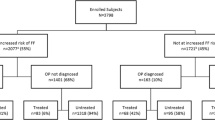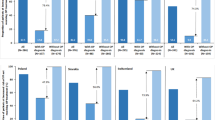Abstract
Summary
Fractures due to osteoporosis are common in older people. This study assessed the management of osteoporosis in a group of 85-year-olds and found both assessment and current treatment to be suboptimal.
Introduction
Fragility fractures are a major cause of excess mortality, substantial morbidity, and health and social service expenditure in older people. However, much less is known about fracture risk and its management in the very old, despite this being the fastest growing age group of our population.
Methods
Cross-sectional analysis of people who reached the age of 85 during the year of 2006 was carried out. Data were gathered by general practice record review (GPRR) and a multidimensional health assessment (MDHA).
Results
Seven hundred thirty-nine individuals were recruited. Mean age was 85.55 years (SD 0.44), and 60.2 % were female; 33.7 % (n = 249) had experienced one or more fragility fractures (F 45.2 % vs M 16.3 % p < 0.001); in total, 332 fractures occurred in these 249 individuals. A formal documented diagnosis of osteoporosis occurred in 12.4 %, and 38 % of individuals had experienced a fall in the last 12 months. When the fracture risk assessment tool (FRAX) and National Osteoporosis Guideline Group (NOGG) guidelines were applied, osteoporosis treatment would be recommended in 35.0 %, with a further 26.1 % identified as needing bone mineral density (BMD) measurement and 38.9 % not requiring treatment or BMD assessment. Women were more likely than men to need treatment (47.4 vs 16.3 %, p < 0.001, odds ratio (OR) 4.62 (3.22–5.63)) and measurement of BMD (40.0 vs 5.1 %, p < 0.001, OR 12.4 (7.13–21.6)). Of the 259 individuals identified as requiring treatment, only 74 (28.6 %) were on adequate osteoporosis treatment.
Conclusion
The prevalence of high fracture risk in the very old is much higher than the documented diagnosis of osteoporosis or the use of adequate treatments.


Similar content being viewed by others
References
Consensus Development Conference (1991) Prophylaxis and treatment of osteoporosis. Am J Med 90:107–110
Johansen A, Evans RJ, Stone MD, Richmond PW, Lo SV, Woodhouse KW (1997) Fracture incidence in England and Wales: a study based on the population of Cardiff. Injury 28:655–660
van Staa TP, Dennison EM, Leufkens HGM, Cooper C (2001) Epidemiology of fractures in England and Wales. Bone 29:517–522
Francis RM (2010) Metabolic bone disease. In: Tallis RC, Fillit HM, Woodhouse K (eds) Brocklehurst’s textbook of geriatric medicine and gerontology, 7th edn. W.B.Saunders, pp 553–565
http://bma.org.uk/practical-support-at-work/contracts/independent-contractors/qof-guidance. Accessed 14 Jan 2014
Kanis JA, on behalf of the World Health Organization Scientific Group (2008) Assessment of osteoporosis at the primary health-care level. Technical Report. WHO Collaborating Centre, University of Sheffield, UK. http://www.shef.ac.uk/FRAX/tool.jsp. Accessed 14 Jan 2014
http://www.shef.ac.uk/NOGG/index.html. Accessed 14 Jan 2014
Office for National Statistics UK. National population projections, 2008-based. http://www.statistics.gov.uk/pdfdir/pproj1009.pdf
Boffin N, Moreels S, Vanthomme K, Van Casteren V (2014) Falls among older general practice patients: a 3 = year nationwide surveillance study. Fam Pract 31(3):281–289
Collerton J, Barrass K, Bond J, Eccles M, Jagger C, James O, Martin-Ruiz C, Robinson L, von Zglinicki T, Kirkwood T (2007) The Newcastle 85+ study: biological, clinical and psychological factors associated with healthy ageing: study protocol. BMC Geriatr 7:14
Collerton J, Davies K, Jagger C, Kingston A, Bond J, Eccles M, Robinson L, Martin-Ruiz C, von Zglinicki T, James O, Kirkwood TBL (2009) Health and disease in 85 year olds: baseline findings from the Newcastle 85+ cohort study. BMJ 399:b4904
Noble M, Wright G, Dibben C et al (2004) The English Indices of Deprivation 2004. Report to the Office of the Deputy Prime Minister. London. http://webarchive.nationalarchives.gov.uk/20100410180038/http://www.communities.gov.uk/publications/communities/englishindices. Accessed 6 Dec 2013
Simpson CF, Boyd CM, Carlson MC, Griswold ME, Guralnik JM, Fried LP (2004) Agreement between self-report of disease diagnoses and medical record validation in disabled older women: factors that modify agreement. J Am Geriatr Soc 52:123–127
Kriegsman D, Penninx BW, van Eijk JT, Boeke AJP, Deeg DJH (1996) Self-reports and General Practitioner Information on the presence of chronic diseases in community dwelling elderly. A study on the accuracy of patients’ self-reports and on determinants of inaccuracy. J Clin Epidemiol 49(12):1407–1417
NICE clinical guideline 146. Osteoporosis: assessing the risk of fragility fracture. http://www.nice.org.uk/nicemedia/live/13857/60399/60399.pdf
Royal College of Physicians (1999) Osteoporosis: clinical guidelines for prevention and treatment. Royal College of Physicians, London
Johnell K, Fastbom J (2009) Undertreatment of osteoporosis in the oldest old? A nationwide study of over 700,000 older people. Arch Osteoporos 4:17–23
Huot L, Couris CM, Tainturier V, Jaglal S, Colin C, Schott A-M (2008) Trends in HRT and anti-osteoporosis medication prescribing in a European population after the WHI study. Osteoporos Int 19:1047–1054
Vannasse A, Dagenais P, Niyonsenga T, Gregoire P, Courteau J, Hemiari A (2005) Bone mineral density measurement and osteoporosis treatment after a fragility fracture in older adults: regional variation and determinants of use in Quebec. BMC Musculoskelet Dis 6:33
Lekkerkerker F, Kanis JA, Alsayed N (2007) Adherence to treatment of osteoporosis: a need for study. Osteoporos Int 18:1311–1317
Solomon DH, Avorn J, Katz JN, Finkelstein JS, Arnold M, Polinski JM, Brookhart A (2005) Compliance with osteoporosis medications. Arch Intern Med 165:2414–2419
Burge RT, Worley D, Johansen A, Bhattacharyya S, Bose U (2001) The cost of osteoporotic fractures in the UK: projections for 2000–2020. J Med Econ 4:51–62
Miller AG, Bercik MJ, Ong A (2012) Nonagenarian hip fracture: treatment and complications. J Trauma Acute Care Surg 72:1411–1415
Chua WM, Nandi N, Masud T (2011) Pharmacological treatments for osteoporosis in very elderly people. Ther Adv Chronic Dis 2(4):279–286
McLellan AR, Gallacher SJ, Fraser M, McQuillian C (2003) The fracture liaison service: success of a program for the evaluation and management of patients with osteoporotic fracture. Osteoporos Int 14:1028–1034
Eastell R, Reid DM, Compston J, Cooper C, Fogelman I, Francis RM, Hay SM, Hosking DJ, Purdie DW, Ralston SH, Reeve J, Russell RG, Stevenson JC (2001) Secondary prevention of osteoporosis: when should a non-vertebral fracture be a trigger for action? QJM 94:575–597
Acknowledgments
The Newcastle 85+ Study has been funded by the Medical Research Council, Biotechnology and Biological Sciences Research Council and the Dunhill Medical Trust. Parts of the work have also been funded by the British Heart Foundation, Unilever Corporate Research, Newcastle University and North of England Commissioning Support Unit (formerly NHS North of Tyne, working on behalf of Newcastle PCT, North Tyneside PCT and Northumberland Care Trust). We acknowledge the operational support of North of England Commissioning Support Unit and of the local general practitioners and their staff. We thank the research nurses, laboratory technicians, data management and clerical team for outstanding work throughout, as well as many colleagues for their expert advice. Thanks are due especially to the study participants and, where appropriate, their families and carers.
Conflicts of interest
Rachel Duncan, Carol Jagger, Andrew Kingston, Eugene McCloskey, Joanna Collerton, Louise Robinson, Thomas BL Kirkwood and Fraser Birrell declare that they have no conflict of interest. Roger Francis is a member of the writing group of the National Osteoporosis Guideline Group (NOGG) and a Trustee of the National Osteoporosis Society. He has served on Advisory Boards for Merck, Sharp and Dohme, Proctor and Gamble, Novartis, Lilly and Servier, all of whom have marketed drug treatments for osteoporosis.
Author information
Authors and Affiliations
Corresponding author
Electronic supplementary material
Below is the link to the electronic supplementary material.
ESM 1
(PDF 2 kb)
Rights and permissions
About this article
Cite this article
Duncan, R., Francis, R.M., Jagger, C. et al. Magnitude of fragility fracture risk in the very old—are we meeting their needs? The Newcastle 85+ Study. Osteoporos Int 26, 123–130 (2015). https://doi.org/10.1007/s00198-014-2837-8
Received:
Accepted:
Published:
Issue Date:
DOI: https://doi.org/10.1007/s00198-014-2837-8




